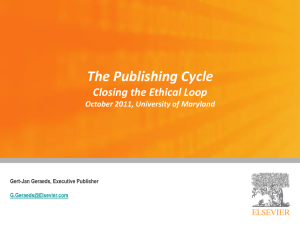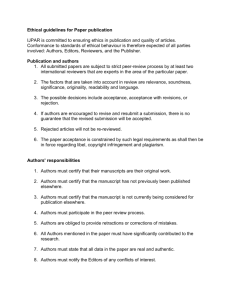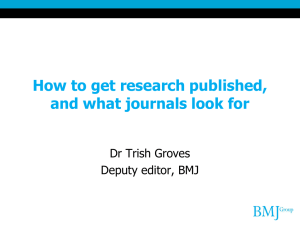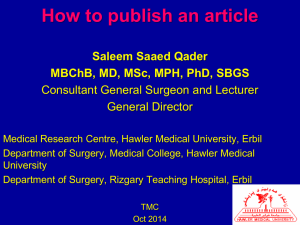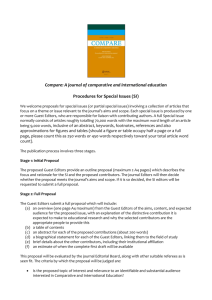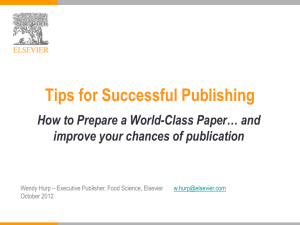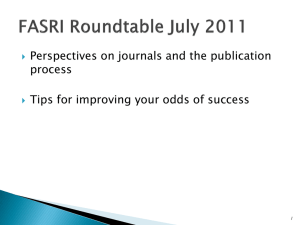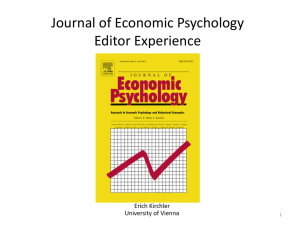University of Ottawa Medical Journal Workshop Feb 11, 2014
advertisement
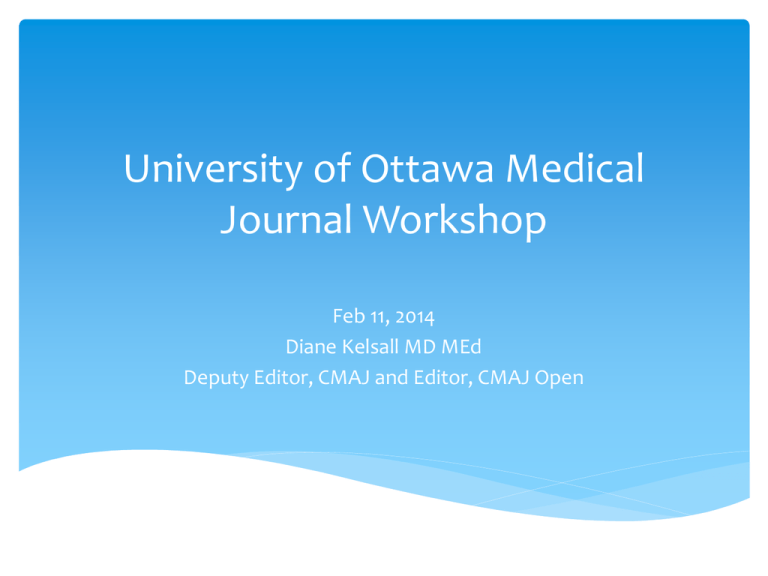
University of Ottawa Medical Journal Workshop Feb 11, 2014 Diane Kelsall MD MEd Deputy Editor, CMAJ and Editor, CMAJ Open CMAJ Medical knowledge that matters CMAJ Open Medical research for all 5 things to know about CMAJ 1. 2. 3. 4. 5. Circulation over 80,000 in print Over 2.2 million unique users at cmaj.ca annually Impact factor of 6.5 1882 articles submitted in 2013 Overall 17% accept rate (5% in some sections) • • • Multi-step process Implications for authors Implications for editors How do we choose articles for publication? Manuscript submission system + 1 manuscript coordinator + 2 editors + 2 peer reviewers How can we do this quickly? Reject most (“red flags”) Peer review some Revision letters for a few Bring the best through to publication • • • • RIOT Relevant Important/Interesting (Original) True Editors are human… We don’t want papers that will require a lot of work Initial evaluation by submission coordinator Use of acceptable file formats? All required components included? Instructions for authors Typical manuscript file First look • Cover letter • • • • • • Correct journal? Commissioned? Previous author correspondence? Any issues raised? Language skills? Author title and position included? First look • Article type • Title • Author list Questions: Are we interested in this topic? Is this the right article type for this topic? Are the authors right for the topic? First look… • Custom” questions for red flags • • • • • Requirements re: word count/tables/figures Competing interests Ethics approval Trial registration Patient consent Read the abstract (for research) Study type we publish? Good research question? [RIO] Formatted for CMAJ? Language skills? Read the article • For research: • Methods first for “T” in RIOT • Use of appropriate reporting guideline • Confirmation of RIO Read the article • For other article types: • RI(O)T • Use of appropriate template • For all articles: • Adherence to template* • Writing style and language skills • Look for plagiarism, misconduct Quick searches Authors Topic Clinical trials registration Run text through for plagiarism Time to first decision? 5 minutes And some get a third… All papers get a second read Make decision Immediate intercept (about 600/1000 in research) Send for review (about 400) Send for review Reviewers do NOT make the decision Instructions for reviewers Select reviewers: Subject matter experts Methodologists Target audience Make decision Decision after review Reject (2 editors agree; ~200 in research) Revision/overhaul (2 editors agree) Bring to manuscript meeting for discussion (~ 200) Revision/overhaul/reject 70 will move forward How to maximize your chances Pick the right journal Consider more than impact factor Decide on your audience What is the journal looking for? Read author instructions Write to fit the journal requirements Don’t think that your paper should be the exception to the rule How to maximize your chances… Decide what your message is. Choose your title carefully Use clear, understandable language Eliminate acronyms Edit your paper carefully Get someone to review it for you Don’t fuss too much with the cover letter Common problems in research papers Difficult to figure out research question Multiple research questions Authors seem unsure of the study type Methods are vague or confusing Multiple designs Common problems in research papers II Underpowered Low response rate Too much data and results not clear Poor structure (e.g., results in discussion or conclusion) Conclusions poorly linked to results or question Unrepresentative Common problems in nonresearch papers The topic and article type don’t match Author groups don’t have appropriate expertise A similar paper recently published in journal Authors have their own agenda Focus is on very rare conditions Article doesn’t conform to template Rambling writing and disorganization Submitting your article Submit the article according to the protocol of the journal Include all relevant components in proper format If you have had contact with the Editorial team, it’s ok to drop a line saying that the article is coming It’s not ok to call/e-mail repeatedly about your paper. If revisions are requested Respond in a timely fashion. Address each revision carefully. Follow instructions for resubmission. If you have concerns about the requested revisions, contact the appropriate person. If your paper is accepted Respond promptly to communications from the journal. If leaving town for a long time, make sure you are reachable or designate someone. Let the journal know. Be prepared to review proofs quickly (within a few days). Be prepared for media involvement. If your paper is rejected Read the letter from the journal carefully. There may be an opportunity to resubmit. Be pleasant in your correspondence. If you have the opportunity to appeal, do so with grace. Admit that your paper can be improved Offer to revise in accordance with editor and reviewer comments Clearly address the reasons for rejection Resources International Committee of Medical Journal Editors (www.icmje.org) World Association of Medical Editors (www.wame.org) Council of Science Editors (www.councilscienceeditors.org) Committee on Publication Ethics (http://publicationethics.org) The Equator Network (www.equator-network.org) Journal websites (including Cochrane, GRADE, AGREE) Formal training options Electives (available at most medical journals) Fellowships (CMAJ, BMJ, NEJM, JAMA, CFP) Council of Science Editors courses Informal training Partner with faculty member on peer review Submit a paper to a journal Sign up to be a peer reviewer
